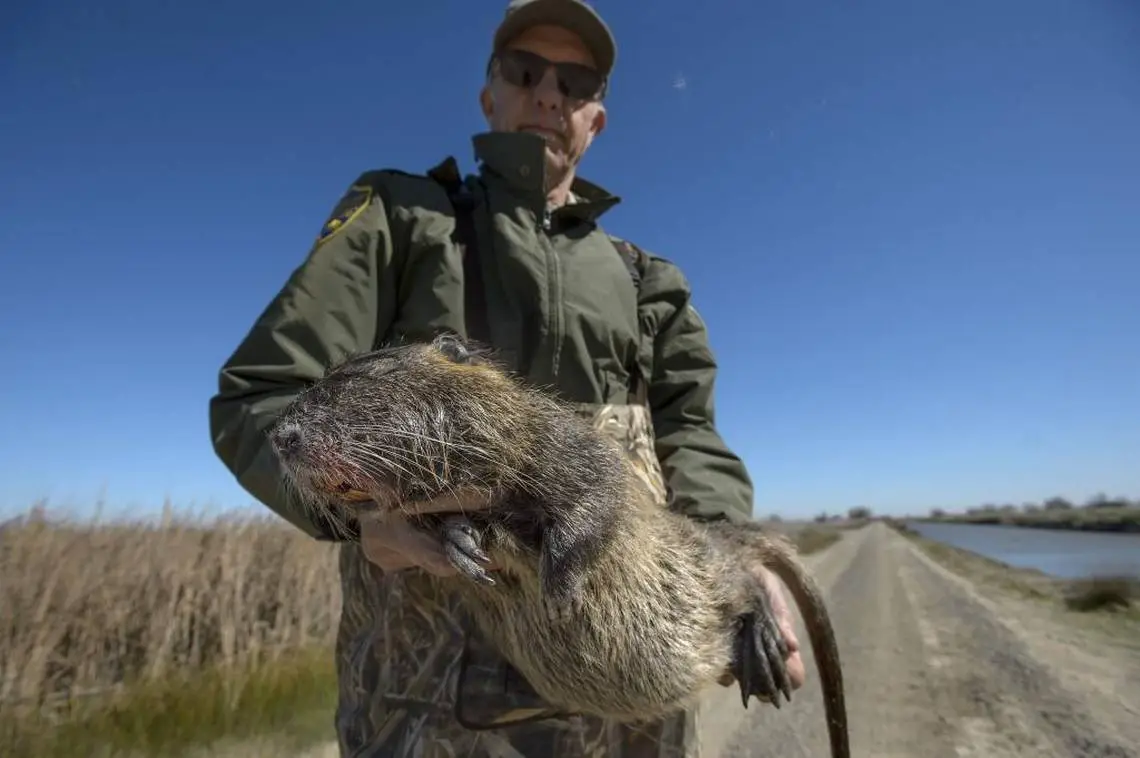Hollywood would have difficulty inventing a rodent as scary as the South American swamp beast that has gained a toehold in the Sacramento-San Joaquin Delta.
Imagine a rat-looking creature weighing about 20 pounds and dragging a tail up to 18 inches long. Its open mouth would reveal two hideously orange buck teeth. Every day it can eat five pounds of vegetation and destroys 20 pounds in the process. Its ferocious burrowing can threaten the stability of an entire levee. The females are basically either pregnant or giving birth, producing up to 30 offspring in a year.
Known by a deceivingly healthy-sounding name —nutria — its eating and burrowing ways can literally destroy natural wetland systems if left unchecked. So far more than 500 nutria have been detected since last year in the Suisun Marsh in the far western Delta.
“We’re very concerned,” said Krysten Kellum, a spokesperson for the California Department of Fish and Wildlife. “They are destroying our wetlands.”
Opinion
This foreign creature has plenty of company in this 700,000-acre estuary. More than 95 percent of the Delta’s fish and plants are non-native. While the Delta may look outwardly bucolic, it is one of the most altered places on earth.
Even so, the nutria represent a potential game-changer, and not in a positive direction, if its population explodes beyond the point of human control. In a real-life version of the arcade game Whac-A-Mole, where players hit fake moles popping out of holes with mallets, the state is using everything from surveillance cameras to dogs that can detect the faintest scent of nutria scat.
Nutria were first detected in Northern California in 2017, mostly in Merced County. By 2019, 47 were detected in the Delta, all in San Joaquin County. None were yet in the Suisun Marsh of Solano County.
By 2021, it looked like the Delta had dodged the proverbial bullet when it came to the nutria. State officials found only three. And then, somehow, the nutria started popping up again.
There is no official explanation for how these swamp rascals made it to the Suisun Marsh. This collection of islands and marshes represents the last land outcroppings in the Delta before the waters flow into the Carquinez Straits and ultimately out to sea.
Steve Chappell, the unofficial guardian of the Suisun Marsh, theorizes that the nutria basically surfed there during big storms in 2023 from somewhere upstream, riding a floating log or a mass of vegetation and disembarking in his marsh.
“We’re at the confluence of the Sacramento and San Joaquin rivers,” said Chappell, executive director of the Suisun Resource and Conservation District, with 30 years of experience in these wetlands. “I think they came probably during one of the high flows into the Delta, and spread from there.”
Before 2023, a nutria had never been detected in Solano County and its marsh. Then suddenly last year, fish and wildlife officials found 166. This year’s count is already double that, at 340, according to Kellum. That’s more than a discovered nutria every day.
Inside the fish and wildlife department is its small army of nutria warriors. “There’s about 40 to 50 staff with boots on the ground from Suisun down to Millerton Lake (in Fresno County),” Kellum said. Within this range, the department has more than 400 cameras that are constantly searching for nutria.
This is not some Hollywood killer rat, but a rodent that likes to be left alone. Chappell saw his first nutria last April, crossing a road on Grizzly Island near dusk and diving into a ditch. Chappell got out of his car. The nutria re-emerged from the ditch. Chappell walked closer. “Once I got close to it, it dove again,” Chappell said. “They’re nocturnal and secretive.”
When cameras capture the image of a nutria or staff find evidence of one (they like to build platforms from which to observe and forage), the state then tries to eradicate the entire local population with traps. Last year, two “nutria scat detection dogs” came briefly from Chesapeake Bay, Maryland, site of a previously devastating infestation, Kellum said. The state is exploring a more permanent canine corps.
“Eradicating nutrias before their populations grow large in California is a necessary action, no matter the immediate cost,” said retired UC Davis Professor Peter Moyle, who has studied state fisheries for more than half a century and was a leading researcher in the Suisun Marsh.
In theory, this cycle of detection and eradication continues until there are no nutria in the Delta. Yet even if temporarily successful, another batch of furry trouble makers coming somehow from upstream may be just one big storm away.
The Delta and Suisun Marsh are no strangers to burrowing creatures such as muskrats and beavers. The potential destruction by the nutria is simply in a league of its own. “Leaving them unchecked and having a big population would be very damaging in the long run,” Chappell said.
California, a state with more than 39 million people that seeks to respect its natural landscapes, has created plenty of environmental conflicts all on its own. But the arrival of the nutria is a reminder that we’re not necessarily in charge of our own lands. In the Delta, an estuary of hemispheric importance given its migratory fish and bird populations, this is a game of Whac-A-Mole that we cannot afford to lose.


Leave a Comment